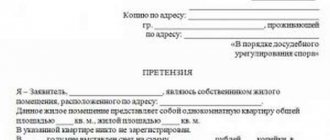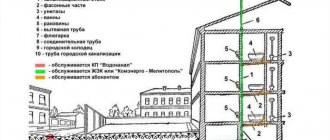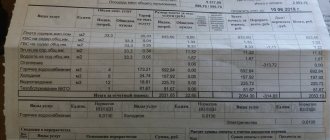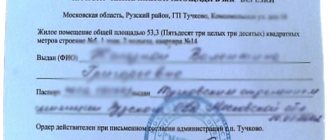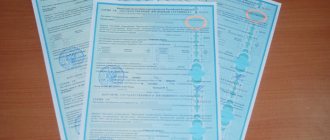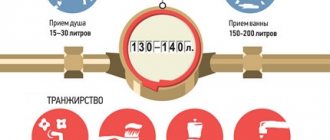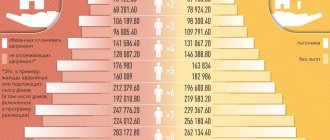Every month, all Russians receive bills for housing and utility services. In particular, everyone has to pay for sewerage.
According to Russian legislation, water disposal is the same public service as the supply of cold or hot water, electricity, gas, and heating.
Do not confuse drainage and water supply. These are two completely different utilities.
The fundamental difference is that the water supply service includes the costs of preparing the utility resource for use.
For example, before moving into a residential area:
- hot water should be heated;
- cold water must undergo a disinfection process.
Drainage, in turn, is the removal of used hot or cold water. Simply put, water disposal is the purification of used water and its disposal through the sewer system.
All residents of the city must pay for this housing and communal services service, regardless of whether they live in an apartment or in a private house.
Housing and communal services are considered to be those services that provide comfortable living conditions in residential premises.
According to the law, all citizens and organizations must pay for housing maintenance and repair services on time and in full.
Housing and communal services are considered:
- Cold water supply. It consists of round-the-clock, constant and uninterrupted provision of high-quality cold water to citizens
. Water supply to the home must be carried out in the required volumes. - Hot water supply. It consists of round-the-clock, constant and uninterrupted provision of high-quality hot water to citizens
. Water supply to the home must be carried out in the required volumes. - Gas supply. It consists of a 24-hour constant and uninterrupted supply of gas to citizens
. Supply to residential premises must be carried out in the required volumes through the connected network, as well as through the sale of gas cylinders. - Heating. It consists of round-the-clock constant and uninterrupted (during the heating season) provision of thermal energy to citizens
. The supply to the living space must be carried out in the required volumes and ensure that the temperature in the room is not lower than the established norm. - Drainage. It is the use of engineering structures to carry out technological processes for draining domestic wastewater from a home.
- Electricity supply. It consists of round-the-clock constant and uninterrupted provision of electricity to citizens. Supply to the home must be carried out in the required quantities.
- Major repairs of common property. This utility payment was introduced on July 1, 2022
. It involves residents making their own payments for major home repairs.
Are discounts on utility bills given to group 2 disabled people? See here.
Most Russians believe that water disposal in utility bills is just a sewer system, that is, a drainage of used water and nothing more.
They are partly right, but this utility payment also includes complex technological processes for drainage, disposal, transportation and further purification of all water that is consumed.
Water disposal includes:
- drainage of hot and cold water that has been used;
- transportation to treatment facilities;
- further cleaning;
- subsequent disposal;
- wastewater disposal.
The Law of December 7, 2011 “On Water Supply and Sanitation” regulates legal relations related to water supply and sanitation through the central water supply system, the procedure for supplying hot and cold water to the population, as well as ensuring water quality.
Before the adoption of the law, these similar legal relations were regulated by various normative legal acts (RLA), many of which continue to be in force to this day.
- resolutions of the Russian Government;
- NLA of the constituent entities of the Russian Federation;
- Legal acts adopted by local authorities;
- local acts of Vodokonals and similar institutions.
After the law came into force, changes were made to it several times throughout the entire period, including in 2022.
It is worth noting that from July 1, all organizations that provide water supply and sanitation will be required to comply with the requirements of the law, according to which production control of the quality and safety of drinking water is carried out.
This means that organizations must draw up a production control program based on the relevant Government resolution and fully implement it.
The rules by which the cost of all housing and communal services is calculated, as well as their recalculation, are regulated by the Decree of the Government of the Russian Federation “On the procedure and conditions for citizens to pay for housing and communal services” and other legal acts.
The amount of payments is calculated based on the readings of individual metering devices (IMU) or common ones.
From 2022, all apartment owners are required to install individual metering devices. If you live in municipal housing under a social rental agreement, meters are installed at the expense of the municipality.
The volume of water disposal in utility bills is the sum of cold and hot water consumed. The resulting figure must be multiplied by the existing tariff
. Tariffs are set by local authorities.
It is worth noting that residents of apartment buildings must pay for sewerage according to the readings of a common building meter, and not for each apartment separately.
In practice, there is no such common household appliance in almost any home.
How to find out utility bills online? Read here.
How to pay utility bills online? Details in this article.
If there are no individual or communal metering devices, then the cost of sewerage in utility bills will be calculated based on general consumption standards established by local authorities.
Such standards are most often approved every year and published in local media, as well as on the official website of the management company.
It is worth noting that in order to install a meter, you must first notify the management company, which must subsequently issue the appropriate permit.
In each region of the Russian Federation, tariffs for sewerage are different.
in 2022, from July 1, sewerage tariffs increased in every region of the Russian Federation. The average price increase across the country was 6-10%.
Examples of tariffs that apply from July 1:
- Krasnoyarsk - 9.42 rubles per cubic meter;
- village of Putilkovo (Moscow region) - 24.31 rubles per cubic meter;
- Moscow - 21.90 rubles per cubic meter.
In payments for housing and communal services (HCS), citizens often discover new, sometimes not entirely clear, expense items, such as sewerage. Not everyone knows what the tariff is on the housing and communal services receipt and whether it needs to be paid.
. However, before accusing management companies of manipulation and inflating utility bills, you need to understand the notorious column and find out where it comes from.
Let's tell you more about the housing and communal services in the receipt - what it is and why you actually have to pay for water twice.
Water supply and sanitation - what is it?
Two key documents regulating the rules for the provision of housing and communal services and separately water supply and sanitation will help you understand this issue.
- Government Decree No. 354 of May 6, 2011 - a detailed overview of this legal act is presented here;
- Federal Law No. 416-FZ of December 7, 2011 “On water supply and sanitation.”
"Law on Housing and Communal Services". Why does everyone ask about Russian Government Decree No. 97 on interbudgetary transfers?
Water disposal is the removal of wastewater from consumer premises to centralized technical networks (sewerage), its transportation for treatment, waste disposal and wastewater disposal.
Simply put, it's a sewer. An ordinary resident of an apartment building or private household receives a bill for housing and communal services, including water - cold and/or hot
.
However, “used” water must be disposed of somewhere—drainage and liquid waste disposal must also be paid for
. A sewer or drainage drain is a separate engineering system, the maintenance and operation of which must be paid for.
Drainage in the receipt - what does this mean: this is the drainage of water that is consumed by residents, and then returns to the sewer - from the shower, toilet, sinks, etc.
Waste raw materials enter treatment facilities, and technical and biological wastewater treatment takes place there. Funds are also required for the maintenance and servicing of this equipment.
. And they are separated from the general payment for water in a separate column.
In addition, it is necessary to ensure protection of the environment from pollution. It is necessary to maintain the level of groundwater contamination at an acceptable level.
The above-mentioned regulation explains how the discharge or runoff of used water is calculated. In fact, everything is simple - how much liquid a citizen consumes, he pays for the same volume
. That is, if 8 cubic meters of cold and 2 cubic meters of hot water were consumed in a month, then you have to pay for the drain of the consumed resource in the amount of 10 cubic meters.
The calculation formula is simple: the consumed volume of water - cold water and hot water - is multiplied by the tariff in force in the region.
This value will differ in different cities:
- in Moscow, for example, the cost of a cube is 19 rubles.
- in Nizhny Novgorod - 10.35 rubles.
- in Saratov - 11, 94.
We hope it is now clearer what drainage is in a water payment receipt. But another question arises: is it possible not to pay for this service?
What is VKGO maintenance in a receipt for an apartment - should I pay or not?
How to calculate the tariff
Water disposal is calculated based on the volume of water already used. The funds received in the form of this utility payment go towards transporting water to treatment plants, operating them and moving clean water back to residential apartments. This indicator is easy to calculate, you just need to use a simple formula: (hot water + hot water) x Tariff rate.
If the consumption of cold (CW) and hot (DHW) water together gives approximately 20 “cubes”, and the tariff rate is 16 rubles, then it will look like this: 20 × 16 = 320 rubles.
Of course, it comes out quite a lot, but nothing can be done about it, because this
calculation formula is established at the legislative level .
However, if the receipt indicates that 7 cubic meters of hot water were spent, 6 cubic meters of cold water (together 13), and 20 are indicated in the “Water Disposal” column, then you should go to court with a corresponding complaint against the utility companies, since this is impossible.
In apartment buildings, as a rule, communal accounting equipment is installed. Based on the information from this device, the total amount of utility bills for sewerage is calculated. And if there is none, then the bill is provided by the utility company. If you want to install your own meter , then to do this you need to draw up an appropriate application, obtain permission and seal it.
Below is a list of organizations that produce water meters:
- "Aqua S".
- "Automation "NTC".
- "Save water."
- “Breeze s+.
- "VodoGazService"
- "Housing and communal services"
- "Intechservice".
- "Teplomag".
- "Oasis".
- "Universal Group".
Water disposal at ODN in 2022
If everything is relatively clear with their apartment, then many residents are also frightened by such a column as one-time use or general house needs. The common property of an apartment building also includes utility and sewerage systems that require maintenance.
What does drainage mean in this aspect? There are radiators that heat the entrance. There is water that the cleaning lady takes to wash the floors in the entrance. There is a tap from which a janitor or gardener draws water for plants in the local area
. We pay for the maintenance of such property.
Residents often come across abbreviations in housing and communal services receipts - DPU and KPU.
Decoding is quite simple. Water disposal of the KPU provides for what is recorded by the “apartment metering device”
. Accordingly, the abbreviation DPU hides a “household metering device”. The scheme is the same - you pay for drainage in the same amount as the amount of water that was “discharged” into the drain.
In most modern apartment buildings, communal meters are installed. These metering devices help determine the amount of payment for wastewater discharge.
If the owner does not agree with the calculations that the management company provides him, he can request reporting documents. As a result, you will have a list or a list of mandatory services and acts, documents confirming calculations.
. Then controversial acts and payments can be appealed in court.
⇐Subscribe to our channel in Yandex.Zen
!⇒
Every month you receive receipts for payment for services consumed. They are awarded to a citizen living in a given residential area
.
They indicate how much we pay for gas, electricity, water, etc.
, etc. An example of a receipt will be given below. In case of accrual of illegal amounts, which means if two receipts are received, with double size, etc., then it is necessary to complain to the authorized bodies.
Value and cost calculation of HVS KPU
Starting from 2012 in the Russian Federation, all apartments must have special control units responsible for accounting for water in housing. This means that when calculating charges for cold water supply in premises of any type, the readings of the installed device are taken into account.
All receipts should be kept
Moreover, such equipment can be shared (apartment) or individual.
You can calculate cold water in an apartment using formula No. 1 (point 42 of the new rules):
Read also: dull colors IN COLOR BALANCE
- The number of cubic meters of cold water consumed during the billing period is determined (usually considered a calendar month);
- The resulting number of cubic meters of cold water is multiplied by the established tariff, after which payment for the service is made.
If the apartment does not have an individual or apartment metering device for cold water, in order to determine the tariff for calculating the cost of the service, it is customary to use formula No. 4 (point 42 of the new rules):
- The number of residents living in the apartment is taken into account;
- For each region, a standard for cold water consumption per resident during the billing period has been determined;
- Payments (receipts) indicate the product of these two values.
Through the cold water service, consumers have the opportunity to receive cold drinking water in the required quantities around the clock.
Who generates receipts for housing and communal services payments?
There are several aspects to consider when answering this question. Thus, according to the law, in an apartment building, receipts for payment of utility services are sent and generated by management organizations. They are authorized to calculate the consumption of the following housing and communal services:
- for water supply;
- per apartment (depending on the number of persons registered there);
- for major repairs, etc.
Citizens receive separate receipts for gas and electricity supplies. This is due to the fact that these organizations are direct suppliers of utility services, and therefore charge directly.
Tariffs for sewerage
All calculations are already presented in the receipt. What is drainage? This is a utility service, the payment for which can be calculated independently. Just like water supply and electricity
.
There are no uniform tariffs in Russia
.
They depend on the management company, the region, and other factors
.
Tariffs are set in compliance with certain criteria: category of liquid waste and wastewater, water quality, and so on. You don't have to go into these complex calculations
. But it is advisable to control your water consumption.
What does a utility bill look like?
A housing and utility bill looks like this: it is a written document that lists the services for which a fee is charged. Tariffs are also indicated there.
The rent act has the following content:
- Indication of the payer.
- Address and location of residential premises.
- The name of the service provider and its bank details.
- QR code.
- Data on the services provided.
- Tariffs that are applied during calculation.
- Total amount to be paid.
Depending on the management company, the receipt may also include services for garbage removal, sewerage, general house needs, heating, etc.
Is it legal to pay for water heating using a receipt in 2018?
If the legality of the additional line “water heating” in receipts is in question, in order not to overpay for heating, it is recommended to first contact the Criminal Code with a request to explain what this item means. The appearance of a new line in the receipt is legal only on the basis of the decision of the owner of the apartment building premises. In the absence of such a decision, you should write a complaint to the State Housing Inspectorate. After filing a complaint with the Criminal Code, you must be provided with an answer with explanations within thirty days. If you refuse to justify why such a service is indicated in the receipt, you should file a complaint with the prosecutor's office with a claim in court. In this case, if you have already paid the amount indicated in the receipt, the basis for the claim will be Article 395 of the Civil Code of the Russian Federation. If a refund is not required, but you must pay for services that are not provided to you, file a claim to exclude the “water heating” line. In this case, it is worth referring to Article 16 of the Law “On Protection of Consumer Rights”.
Housing and communal services and housing and communal services - what are they and what is the difference
Before you understand the difference between these concepts, you need to understand the meaning of this abbreviation.
Housing and communal services is understood as housing and communal services as a branch of the economy engaged in the study and formation of a range of services necessary for the normal life support of the population.
Housing and communal services are housing and communal services, that is, a specific resource provided to citizens - electricity, hot water, etc.
The concept of housing and communal services is much broader than the concept of housing and communal services, and includes, in addition to the list of services, other essential provisions, legal norms, standards, etc.
What is KPU drainage system?
Drainage system KPU
KPU drainage system Answer: The concept of KPU drainage system can be encountered by apartment owners in many buildings. It means drainage, that is, draining all wastewater. In this case, the total amount of hot and cold water spent for general house needs goes down the drain. However, this formulation is largely incorrect, which misleads consumers. What is the problem with accounting for general house water consumption? Many who regularly pay for housing and communal services doubt the correctness of the values in this column. What is hot water supply, hot water supply and sewerage in housing and communal services receipts? Having received a receipt for paying for a utility bill, many Russians look at it with bewilderment, trying to understand what is encrypted in the mysterious abbreviations, and for what services they need to shell out quite a lot of money. Unfortunately, until now utility companies have not bothered to bring the receipts issued in different regions of Russia to a single standard. The situation is as follows, in our apartment, before installing water meters, the calculation of consumption was calculated according to DPU DHW DPU 50m3 per month Cold water supply DPU 49m3s per month For those who do not know cold water supply DHW hot water supply DPU - house metering device KPU - apartment metering device In another apartment in another area, we have had water meters for a long time, and despite the fact that we very often use a washing machine, a dishwasher, we wash ourselves by filling a two-seater Jacuzzi, we wash our hands in the shower, we wash the water, we drink water, and we use the toilet at full capacity, the total consumption of hot water + hot water is approximately 5-10 m3. Okay, we think since we don’t have meters in this apartment, then the EIRC can mock as it wants, taking revenge on conscientious payers for malicious non-weavers. We didn’t wait long and experience injustice, we installed and registered water meters in the Otradnitsa apartment as required, well, we think now everything will be fair, now we’ll pay according to our consumption, now we’ll be happy. Water disposal in utility bills Every month, all Russians receive bills for housing and utility services. In particular, everyone has to pay for sewerage. According to Russian legislation, water disposal is the same public service as the supply of cold or hot water, electricity, gas, and heating. Do not confuse drainage and water supply. What is KPU WATER BRANCH? Marina Stepanovna Znatok (260), closed 5 years ago In Cheryomushki, in the payment for an apartment there is first HVS KPU (these are cubes for cold water), then this incomprehensible WATER SUPPLY KPU, and then DHW KPU (hot water). In the cold and mountains There is a water meter in the apartment, and it is immediately clear how many cubic meters of water have been used. The toilet also goes through the meter. Vodootv.DPU crazy numbers Hello! Help me to understand. I’m only installing the KPU now, the house is old, the pipes are bad, there were problems with the installation. Therefore, for now we are paying according to the DPU, the installation of meters is in progress.
But that's not even the point. The point is in the crazy figures for the drainage costs of the DPU. According to the receipts, we pay for the hot water supply of the DPU, this is understandable, the cold water supply of the DPU is also understandable, BUT also the drainage of the DPU.
What is drainage when paying for water by meter?
What is drainage when paying for water by meter? Drainage. in receipts for payment of utility services of a management company or resource-supplying organization, in the case of providing utility services directly by them, this is a utility service for the drainage of a communal resource supplied to a residential premises - waste water, used for the communal and domestic needs of the owners of residential premises and fecal matter, along the installed drainage system from each apartment building to the receiving collector, and then to the treatment plant. What is drainage? “The management company issues us a monthly bill for housing and communal services. In particular, we pay three times for water, hot and cold, and sewerage. What is hidden under the tap, and why do you have to pay for it, since we already pay for water? Sincerely, Sitnikova L.I.” According to federal law, sewerage is the same public service as hot and cold water supply, heating, electricity and gas supply.
Legal regulation
In the housing and communal services sector, legal regulation includes such legal acts as:
- Constitution of the Russian Federation.
- Housing Code.
- Law on Privatization.
- Government decree in the housing and communal services sector.
- Private contracts.
- Regional legal acts.
It is in these legal documents that tariffs for utility services, the procedure for their payment, the procedure for repaying debt obligations, etc. are reflected.
As a rule, regulation most often occurs at the regional level, so special attention should be paid to the regulatory legal acts of the constituent entity of the Russian Federation.
How to refuse KPU maintenance
and all sanctions will actually begin from this year, because the absence of a certificate of timely verification is equated to the absence of a meter as such, accordingly the Criminal Code will begin to charge at the current tariff, this time, but here the Jewish nature of some residents is very often included: and There are two people registered with me, but four people live, it’s more profitable for me without meters, and this case is now provided for: starting this year, increasing coefficients are being introduced to calculate the cost of water in apartments that are not equipped with water meters https://www.rg.ru/201. /schetchik.html.
Moscow Government Decree No. 344 dated April 16, 2013 was issued. , according to which from January 1, 2015. increasing coefficients will be applied to the standard for those who did not voluntarily install meters. Also, increasing coefficients will be applied to those who did not check on time, who did not replace a broken meter, this may also apply to those who did not allow the inspector into the apartment.
Explanation of abbreviations on the receipt
A utility bill includes a lot of abbreviations that need to be deciphered and understood. Each abbreviation is designated by a set of letters and has its own name. Let's look at some of them.
SEON
This is a rather specific column in utility bills. SEON stands for unified public information system
. As a rule, this includes sending messages to citizens about impending natural disasters, etc.
SOI
This is one of the most common columns in a payment order. It stands for the phrase “maintenance of common property.” It obliges citizens to pay mandatory expenses for the needs of common property in the house. SOI includes:
- maintenance of stairs;
- entrances;
- elevators;
- attic, etc.
The amount of payment for SOI is determined by an agreement between residents and the management company.
ROM
This payment applies only to those houses where an intercom is installed. The abbreviation stands for: “ intercom-locking device ”. In some cases, the fee for ROM is issued as a separate receipt.
Citizens are required to pay for its maintenance and maintenance of normal technical condition.
ONE
General house needs are an analogue of SOI . These are also expenses for the maintenance of common property
. There are no differences in these abbreviations; it all depends on what set of letters the management organization uses to indicate these expenses in the payment slip.
UUTE
UUTE in the receipt is responsible for the provision of thermal energy to apartments. It reflects how many resources were supplied and at what tariffs the payment is calculated. The inclusion of UTE occurs depending on the season. Explanation of the abbreviation: thermal energy metering units.
DSCPT
Stands for “additional cable program television systems.” This column is not available on payment cards in all regions.
.
It constitutes a fee for the provision of telecommunication services, maintenance of a common house antenna, etc.
DSKPT can be appealed by a citizen in a situation where he uses cable TV and an antenna.
POVK
In order to understand what POVK means, you need to refer to the norms of housing legislation. This is an additional fee for providing heat to the apartment. A couple more letters are added to this abbreviation, for example, ТХВ.
APPP
APPP involves citizens paying for the development and maintenance of systems that protect the house from sudden fire. Such systems do not protect the apartment itself, but entrances, stairs, attics, etc.
AUR
AUR is also a specific line of expenses in payments. This includes a set of payments aimed at ensuring the work of the administrative and management apparatus, for example, a management company.
OPU
OPU includes the volume and types of costs for the collection, repair and installation of various metering devices, such as water or gas meters.
ELDT
This is the “daily consumption on the electric meter”. As a rule, such consumption is not indicated in all regions. The night consumption of the EBDT can also be indicated in a separate line.
TPP
TPP includes payment for water - “coolant”.
VDGO
The interpretation of this concept includes the provision and maintenance of gas equipment. VDGO includes stoves, gas boilers, and water heaters. Citizens are required to pay for inspection, repair and maintenance of these devices.
PD number
This is the payment document number! It is used by housing and communal services management companies, and it is also convenient for the tax inspectorate and other organizations.
Water disposal in housing and communal services receipt
Citizens are also required to pay for wastewater disposal. Payment for this is charged every month. The management company issues such a receipt and also issues an invoice for the allocation.
Water supply
DHW and cold water are indicated in a separate column. This is, in essence, the supply of hot and cold water to the apartment. This is done through common pipes.
DHW
DHW refers to the provision of hot water supply. The column must be filled out in accordance with legal requirements. There is no charge for the consumption of hot water in situations where there is a hot water heater at home.
HVS
This is the supply of cold water to the apartment. Payments are collected based on common metering devices (shared in the building) or on individual ones located in the apartment. The calculation is generated for a certain period.
Heating
Abbreviations for heating have already been discussed above. It should be noted that the provision of this service is seasonal and, for example, in the summer, no payment for heat is charged.
What does the abbreviation HVS DPU mean?
Business lawyer > Housing and communal services issues > Utilities > What does the abbreviation HVS DPU mean?
Residents of apartment buildings who receive bills to pay for utilities often come across such an abbreviation as “HVS DPU”. In most cases, the decoding of this abbreviation cannot be seen on receipts, so many owners of residential premises are interested in the question of what this abbreviation means.
Utility payments
What fees are charged for the provision of utility services? Photo No. 1
In order to understand this abbreviation, residents and owners of apartments in multi-storey buildings must have a complete understanding of all utility bills that are calculated for the services provided.
According to current regulations, residents of high-rise buildings are provided with the following utilities, for which they must pay:
- supply of electrical energy, for which payment is made according to installed meters;
- gas supply for cooking, heating water, and in some cases heating (if the apartment is equipped with an autonomous heat generation system);
- removal of garbage and other household waste;
- cleaning staircases and other landings of an apartment building, its outdoor area, as well as the funds necessary for routine repairs;
- supply of cold water, as well as hot water for heating;
- wastewater, that is, the purification of water that has been used, that is, sewage discharges.
In some regions, additional utilities may be installed, then they will be used as a different payment document, but at the moment this is rare.
In some cases, utility workers, when filling out the fields of payment documents, allow for abbreviations, or even write the abbreviation of the service provided, which confuses some citizens. Among such abbreviations, HVS DPU is often found.
It is important to remember that enterprises that provide utility services must provide all information about them upon the first request of the consumer, that is, the owner or tenant of the apartment.
An abbreviation found on bills
An abbreviation found in bills for utility bills. Photo No. 2
In most cases, you can find such abbreviations that appear in payment documents - GVS, GVS KPU, KhVS, KhVS DPU.
Let's take a closer look at them.
DHW means hot water supply, which is used for heating residential premises, that is, water flowing through the radiators. At the moment, there are two types of accounting. The first involves monitoring its quantity using a meter, which is located on the heat main of the boiler house or other enterprise providing such services. The second is the installation of a common house meter, that is, a KPU - a communal metering device.
The nuance is that if accounting is kept by an enterprise, then it will blame all kinds of losses in water and its temperature (for example, breakthroughs, leaks) on consumers, and they will pay for it. If a house has a communal meter installed, then residents will pay for the water and heat supplied to the house.
Cold water supply means the supply of cold water, which is used for cooking, and other needs of residents (for example, sewage). Its accounting is carried out in two ways. The first involves the establishment of a special standard for each resident of the apartment, in the form of monthly cubic meters (for example, for one person the standard is 3 cubic meters, if 2 people are registered, it means that the payment will be for 6 cubic meters consumed, even if people consumed less).
The second involves equipping each apartment with an individual meter, which will take into account the cold water consumed; the data on it is transferred to the water supplier every month, and he issues an invoice based on it. Therefore, in this case, the payment slip will contain the abbreviation HVS DPU, that is, the payment for cold water supply according to the home meter.
It is important to remember that water meters must be installed by citizens at their own expense.
What is more profitable: standard consumption or a meter?
Is it worth installing a meter for the amount of hot and cold water consumed? Photo No. 3
The answer to this question is very complex, and lies in how a particular family uses water in general. If everything is clear with the hot one, it is used for heating, then with the cold one some questions may arise.
Having analyzed situations where a consumer consumes water according to the standard, we can come to the following conclusions:
- he does not have a record of how much water was consumed, even if he consumes less, he will have to pay money for what was not used;
- if one person is registered in an apartment and several people live in it, then some savings can be achieved, since the payment will be received for the number of cubic meters per person;
- if the owner likes to bathe often or uses a lot of water, then the best choice for him is standard consumption.
Now let's consider the option when consumption goes through a meter. In this case, payment for water will be made only according to the readings of the meter (meter), so citizens can save significantly by reducing water consumption. But this option, as mentioned above, is not suitable for those who consume a lot of water, or if many people live in the living space.
These are the nuances that occur when using cold water.
It is important to remember that if the owner or members of his family do not live in the apartment for some time, they can submit an appropriate application stating that they will not live for such and such a period of time. Utilities should not be charged for it.
How to detect deception?
How to check whether payments for consumed utilities are calculated correctly? Photo No. 4
Of course, utility companies are trying in every possible way to write off their losses on consumers, so sometimes situations arise when the charge suddenly goes not according to the meter, but according to the standard, or the bills indicate larger amounts than the actual amount consumed.
To eliminate the situations that have arisen, the consumer is obliged to take the agreement with the utility company, the received payment, documents and the act of installing the metering device and go to the accounting department of such an enterprise, where they write an application for recalculation.
If this does not happen, you can write complaints to Rospotrebnadzor and law enforcement agencies, demanding that the perpetrators be punished and recalculated.
It is important to remember that recalculation can also be made by court decision if the consumer files a claim there.
The abbreviation HVS DPU means payment for consumed water, according to the house (apartment) meter.
You can find out what payment receipts for utility bills look like by watching the video:
Noticed a mistake? Select it and press Ctrl+Enter to let us know.
28 Jun 2021 kasjanenko 9
Application for a reduction in payment
A reduction in payment can occur for various reasons, for example, due to the fact that the family is low-income, a disabled citizen lives in the apartment, etc. The application must be in writing
. It can be submitted either directly to the organization that provides the service or through a multifunctional center. The application can be completed by the resident or a representative.
A sample application for recalculation (reduction) of payment for utility bills can be downloaded here. ⇐
Peculiarities
According to Decree of the Government of the Russian Federation No. 354 of 05/06/2011, the supply of cold and hot water and wastewater disposal are public services provided by contractors to consumers. Performers are municipal and private enterprises, consumers are owners of private houses, various organizations and enterprises.
What is included in utilities:
- Citizens are provided with high-quality cold water around the clock and uninterruptedly. Water is supplied to homes in the required volumes.
- Citizens are provided with high-quality hot water around the clock and uninterruptedly. Hot water is supplied to homes in the required volumes.
- Residents of the houses are provided with gas around the clock and uninterruptedly. Gas is supplied in the required volumes through the connected network, as well as using gas cylinders.
- Citizens are provided with thermal energy around the clock and uninterruptedly (during the heating season). They supply heat energy in the required volumes and maintain the temperature in the room not lower than the established norm.
- Electricity supply. Citizens are provided with electricity around the clock and uninterruptedly.
- Residents pay their own fees for major home repairs.
- Citizens are provided with sanitation.
What is drainage on a water bill? The services provided in 2021 are:
- Preparation and supply of cold water . The performers prepare and transport it to consumers. The water is filtered, purified, and laboratory tests are carried out. Then they service pumping stations, repair central water supply networks, and carry out complexes of work to supply water through distribution pipelines to internal consumer networks.
- Preparation and supply of hot water. Boiler rooms are serviced (here the water is heated), and the routes are maintained in working order. According to them, it is supplied to consumers. If the boiler rooms are autonomous, and the apartments have gas water heaters, there is no such service.
- Drainage. Wastewater from consumer premises is discharged into the sewer system, transported for treatment, waste is disposed of and wastewater is disposed of.
Thus, we see that drainage is the removal of wastewater from premises . This is the total consumption of hot water (hot water) and cold water (cold water), its purification and subsequent disposal using the sewer system.
The counter will help you count it. But there are no metering units for sewer networks in apartments. The KPI is indicated on the receipt for owners who pay housing and communal services for the apartment. DPU - for owners in a private house.
The Law of December 7, 2011 “On Water Supply and Sanitation” regulates legal relations related to water supply and sanitation through the central water supply system, the procedure for supplying hot and cold water to the population, as well as ensuring water quality.
What is drainage in utility bills? In fact, citizens pay for the work of flushing the toilet, bathtub, and kitchen sink. All the water that goes into the apartment according to the meters is sewerage.
It is necessary to distinguish between “water supply” and “sewage disposal” in the receipt . These are two completely different concepts. The payment for water supply includes the cost of water treatment. The hot one is heated, the cold one is disinfected. Drainage – disposal of used water.
If the house has a separate common house meter (ONE in the receipt), each of the home owners must pay for both their own needs and the needs of the house. With the help of such meters, the amount of water consumed by the entire house is determined.
Sometimes buildings are equipped with meters that determine the volume of drainage (KPU - collective metering device). Accurately shows the amount of sewer work completed.
If there is no ODN meter, changing the water supply in the receipt taking into account the consumption for general house needs is illegal . There are no standards for general household needs, and any standards applied locally are regarded as arbitrariness.
Rules for reducing rent
In this matter, the following points need to be taken into account:
- You can reduce the fee when providing low-quality services.
- In the absence of necessary maintenance of metering devices.
- With illegally inflated fees.
- In situations where the fee exceeds 20 percent of total income.
Only in these situations can you really count on a reduction in utility bills. Everything happens exclusively at the written request of the person, since the reduction is exclusively of a declarative nature.
Thus, the receipt includes many alphabetic symbols and codes: IPU, IND, ZPU, ADS, AZU, AKHN, BULA, VIC, ASPZ, AHR, IKU, OID, SOID, GUP, etc. Essentially, this is one and the same same name for different utilities
. For example, OID and SOID apply to the general property of MKD, IPU and IND - mean payment for metering devices, ZPU and ADS - also to metering devices in terms of sealing.
In receipts for payment of housing and communal services there is a column “sewage”. This is a separate service for which you need to pay in the same way as for the supply of water, electricity, and heating. In this article we will explain what it is - drainage on a receipt, what is included in the service and what affects the payment amount.
Drainage system KPU
The concept of KPU drainage can be encountered by apartment owners in many buildings. It means drainage, that is, draining all wastewater. In this case, the total amount of hot and cold water spent for general house needs goes down the drain. However, this formulation is largely incorrect, which misleads consumers.
- There are no metering devices for water discharged into the sewer system that could separately calculate how much is spent on general household needs. Therefore, this column can indicate almost any values that will be convenient for the service provider, since the end consumer will not be able to verify or refute them;
- laws do not contain this wording. What payments the management company can demand from people is prescribed by law. Therefore, all correct columns contain the entry “common house” or “common.” metering devices. You can actually check them and compare the charged fee with the real values.
What does the drainage service include?
Let's take a closer look at what drainage is in utility bills. This service includes complex technological processes:
- removal of used hot and cold water;
- transportation of domestic wastewater to treatment facilities;
- further cleaning;
- disposal;
- wastewater disposal.
What does the line on the receipt look like?
Wastewater disposal is presented as a separate line on the receipt. It consists of the following points:
How to check housing and communal services debts
There are different ways to check utility debt. Choose the one that is most convenient for you - in this
article
- the number of cubic meters of hot and cold water used over the previous month (meter readings are taken into account);
- social norm (taken into account in cases where meters are not installed);
- tariff for sewerage established in the region;
- debt at the beginning of the month (if any);
- penalty for late payments (if there is a debt);
- accrued - the amount of payment for sewerage for the past month is indicated here;
- recalculation (performed if a person has benefits for paying for utilities, as well as at the request of the owner (for example, about recalculating rent in case of temporary absence));
- recorded payment (payments made previously);
- total - the total amount of the current payment, taking into account the debt, penalties and recalculation.
What determines the amount in this payment line?
The amount of payment for sewerage is influenced by 2 factors: the presence or absence of meters and the tariff set by the local administration.
If meters are installed, then at the end of the month readings are taken from them and multiplied by the tariff in force in the region. If there are no such devices, then the calculation is based on social norms. It is established by local governments
.
The standard is too high, so in this case the amounts of payments for sewerage are higher than those that are formed when taking into account meter readings
.
In different regions, local governments set their own tariffs for wastewater disposal. Their size depends on the condition of the sewer systems in a particular city, as well as on the availability of modern treatment plants and equipment for the disposal of household wastewater.
Formation of tariff for drainage
The tariff for water disposal is subject to separate determination in each region, which is carried out by a special authorized body.
- The parameters for calculation are the following indicators:
Climatic features of each specific area. Condition of sewer networks. Condition of water supply networks. Distance for pumping water and waste. Condition and quality of pumping station equipment. The number of citizens consuming this service. Payment for the work of emergency crews responsible for maintaining the condition of the network. Ensuring and monitoring the performance of automated control systems. Payment to water utility workers.
- As an example, several tariffs for wastewater disposal:
Rostov region — 24.26 rubles/cubic meter Moscow region — 23.43 rubles/cubic meter Surgut — 25.44 rubles/cubic meter
Service cost
According to Decree of the Government of the Russian Federation No. 392 of July 30, 2004, the amount of payment for the provided utility services should be determined by multiplying the volume of consumed utility resource - in this case, wastewater consumption - by the amount of the approved tariff.
In the absence of metering units, the costs of consumed cold and hot water, and, consequently, the amount of water disposal, are determined according to standards approved by local authorities in each region of the Russian Federation and in cities of federal significance - Moscow and St. Petersburg.
Tariffs for water supply (cold and hot) and for wastewater disposal also differ in different regions of the Russian Federation. You can find them on the official websites of local authorities or on the pages of enterprises providing these services.
What to do if there is no meter?
The simplest and most economical way to account for water consumption is to use individual meters. But not all residential premises or private households have them installed yet
. For such residents, approved consumption standards are applied, according to which calculations and wastewater disposal are carried out. They are enshrined in regulations of local authorities
. These standards far exceed the figures that reflect the actual volumes of resource used.
To know how much to put in a receipt for a given resource, the following criteria are taken:
- the number of persons living in this living space;
- average standard water consumption in cubic meters per person;
- tariff established by local authorities for 1 cubic meter of wastewater disposal.
By multiplying all three indicators, you get the amount that will be reflected in the receipt for utilities for this item.
Standards are constantly being revised upward, which encourages the population to install individual meters.
How to check if hot water charges have been charged correctly
Housing and communal services receipts for payment of utility services sometimes contain strange names and abbreviations: abbreviations DHW KPU, DHW DPU, water heating service, etc. This makes consumers nervous and suspicious of tariffs and accrued payments. Regulation of tariffs for hot and cold water supply, as well as sanitation, is carried out by the state, on the basis of Russian Government Decree No. 406, adopted back in 2013. This article contains information in simple words:
- explanation of what DHW KPU (DPU) and water heating are;
- calculation of consumed thermal energy;
- checking the correctness of charges for hot water supply in the receipt.
Hot water supply: tariff system, control metering devices
First the decoding:
- DHW KPU - hot water supply according to control metering devices;
- DHW DPU - hot water supply via household metering devices.
Hot water control units can be installed in apartments and used as individual metering devices for hot and cold water consumption. The housing and communal services receipt must indicate the readings of both communal and individual meters.
Payment for hot water supply is charged only if there is a central hot water supply, while water is used both as a heat carrier for heating premises and for domestic needs (as hot water).
- If there is hot water in the house, then consumption should be recorded using two general house or individual meters: one is installed on the hot water risers and shows the consumption consumption in cubic meters, the other - on the branch of the heating system and shows the amount of thermal energy consumed in Gcal.
- In houses where there is only cold water, charges for hot water are charged only during the heating season.
- If an apartment uses a boiler or gas water heater to heat water, residents pay for the energy consumed (electricity or gas).
- Some MKD apartments use a dual-circuit heating system: one is connected to the central hot water supply system;
- the other to individual internal water heaters (in case the hot water is turned off).
Tariffs for hot water supply
According to section II, clause 4 of post. No. 406, regulated state tariffs for hot water supply consist of tariffs of the following type:
- for hot water;
- for transportation through the central hot water pipeline;
- to connect the in-house system to the central system (CS) of hot water supply.
How are hot water tariffs set?
Clause 88 of Resolution No. 406 establishes a 2-component tariff for hot water, which consists of a component for cold water and a component for thermal energy (or water heating).
Thus, the cost of hot water Sgw is determined as the sum of the costs of cold water Sxv and its heating (heat energy) Ste:
Sgv = Sхv + Ste (1).
Previously, the cost of hot water was determined by f‑le:
Metering devices for wastewater disposal
In Russia, there are special wastewater metering devices. However, utilities are in no hurry to install them, since the introduction of new equipment is associated with costs.
Still, it’s worth getting acquainted with wastewater meters; they come in several types:
- ultrasonic device,
- electromagnetic counter,
- lever or pendulum device.
The first option is considered the most economical of them. It accurately determines the volume of consumption. However, the cost of such devices is high, so they are not very popular.
An electromagnetic meter is the best option. It collects information well and will help you save on utilities.
The last option is a budget option that is very popular. However, such a counter produces small errors. But you can still save on sewerage costs, since you will only pay for what you consume.
Installing a drainage meter will allow you to save on the cost of utilities, so it’s worth taking advantage of the opportunity presented.
How to calculate water drainage using a meter
The calculation of fees for wastewater disposal includes several important indicators and is determined taking into account the specifics of the region. The amount payable is calculated in the following ways:
- based on the readings of an individual water meter, which determines the volume of its supply, and installed in a separate apartment;
- according to data from common house metering devices;
- according to established standards.
Of these three methods, the most beneficial option for the user is with a personal water meter in the apartment.
Tariff for payment for sewerage in an apartment building
In the Russian Federation there is no uniform tariff for wastewater disposal in apartment buildings, since the price depends on several characteristics:
- climate of the region - the level of payment increases for cold regions, since it requires utility structures to increase the cost of maintaining communications;
- degree of deterioration of the sewer system;
- condition of water supply networks;
- remoteness of farm facilities;
- location of pumping units;
- number of connected consumers;
- the volume of costs for the work of emergency workers and utility workers.
Taking into account the combination of these factors, the tariff for wastewater is set by decree of regional authorities.
Water metering devices
In addition to calculation using the formula, specialized accounting devices are used to determine the volume of wastewater.
But with the introduction of such equipment, difficulties arise due to the need to allocate additional funding for the purchase and installation of meters.
Equipment that takes into account the volume of wastewater is divided into the following categories according to its operating principle:
- ultrasonic;
- electromagnetic;
- mechanical (lever or pendulum).
Ultrasonic devices are the most economical to account for, but are expensive to purchase, which explains their low popularity. The best option is an electromagnetic meter, with acceptable measurement results at a reasonable price.
The most popular devices are mechanical, due to their low cost. Their disadvantage is the low accuracy of wastewater flow measurement.
Calculation of the cost of wastewater disposal
The calculation is performed using the formula:
OS = (PHV + PGV) x T, where
- OS – amount of payment for wastewater;
- PCV and PGW - monthly payments, respectively, for cold and hot water supply;
- T – tariff assigned for wastewater disposal.
The payment is calculated monthly and entered into the receipt as a separate expense item.
Tariffing or self-payment
Calculating the receipt column is quite simple: water disposal is equal to the sum of hot water and cold water multiplied by the tariff. For example, the supply of water flows is 20 m3, the tariff is 20 rubles, the total amount is 400 rubles. However, if the payment line shows a total receipt of 20 m3, and a total drainage of 25 m3, this is unacceptable; there is a common deception of public utilities, which can be challenged in court.
Apartment buildings often have a common building meter, which shows the amount of payments, but if it does not exist, the calculation is issued by the housing and communal services through the service provider company. If necessary, you can always install your own meter by first submitting an application for installation of the device. As soon as the permit is issued, the meter is installed, sealed and the amounts due for payment are recalculated. Look at the photo to see what the counter looks like.
What is KPU? This question is often asked by users. KPU is a collective metering device installed in a common household manner. In other words, KPU is a counter that shows how much sewage has been drained over a given period of time. However, the abbreviation KPU is not in any official document; in the lines and columns there is “Common house or common house. utility metering devices." It turns out that the KPU is an invention of the housing and communal services sector and nothing more, especially since the use of abbreviated names of devices in official documents is not allowed unless specified by the rules or an addition to the resolution.
And, most importantly: Decree of the Government of the Russian Federation dated April 16, 2013 No. 344, payment for housing and communal services for wastewater consumption has been cancelled. Cancellation date: 06/01/2013. The document “On Amendments to Certain Acts of the Government of the Russian Federation on the Provision of Public Utilities,” therefore, if your housing and communal services do not know about this, it would be useful to remind them of this by attaching a photo or copy of the document.
Video: Who pays for what for housing and communal services!
Since 2022, another line has appeared in receipts for utility bills - “Water disposal.” In a simplified sense, this means the discharge of water used by apartment residents into the sewer system.
In fact, water disposal is a technically complex complex process of water utilization, including its collection after use, purification and transportation to reservoirs, mainly rivers or lakes outside the populated area. The treatment is carried out in accordance with environmental regulations, according to which water contaminated with impurities and chemicals must not be discharged.
The contractor with whom the municipality, management companies, cooperatives or private individuals have entered into an agreement for the provision of utility services is responsible for the smooth functioning of the process.
In many localities this is a unitary enterprise (or JSC, OJSC) Vodokanal. And all owners of apartment buildings and private houses connected to the general sewer system pay for sewerage costs.
Law
The main regulatory document regarding water supply and sanitation of houses is Federal Law dated December 7, 2011 N 416-FZ. It regulates the procedure for providing services to the population and organizations by relevant companies.
This law regulates the following principles and objectives within the framework of water supply and disposal:
- powers of government authorities at all levels in this matter;
- the procedure for supplying hot and cold water and its disposal;
- ensuring and monitoring the quality of supplied water;
- principles of environmental conservation in this field of activity;
- regulation of the application of tariffs.
The procedure that public utilities follow when providing services to the population is prescribed in the Rules approved by Decree of the Government of the Russian Federation No. 354 of 05/06/2011. It also defines services for the supply and disposal of water to apartment buildings and private buildings.
